The Tau Canis Majoris Cluster is a bright open cluster located 4,830 light-years away in the constellation Canis Major. With an apparent magnitude of 3.8, it is visible without binoculars in good conditions. The cluster has the designation NGC 2362 in the New General Catalogue. It surrounds the bright star Tau Canis Majoris, one of the most massive and luminous stars visible to the unaided eye.
The Tau Canis Majoris Cluster has an estimated age of about 5 million years. In comparison, the brighter Pleiades and Hyades clusters in the constellation Taurus are believed to be 75-150 and 625 million years old.
NGC 2362 has a mass of more than 500 solar masses and contains between 100 and 150 member stars. An additional 500 stars form a halo around the cluster.
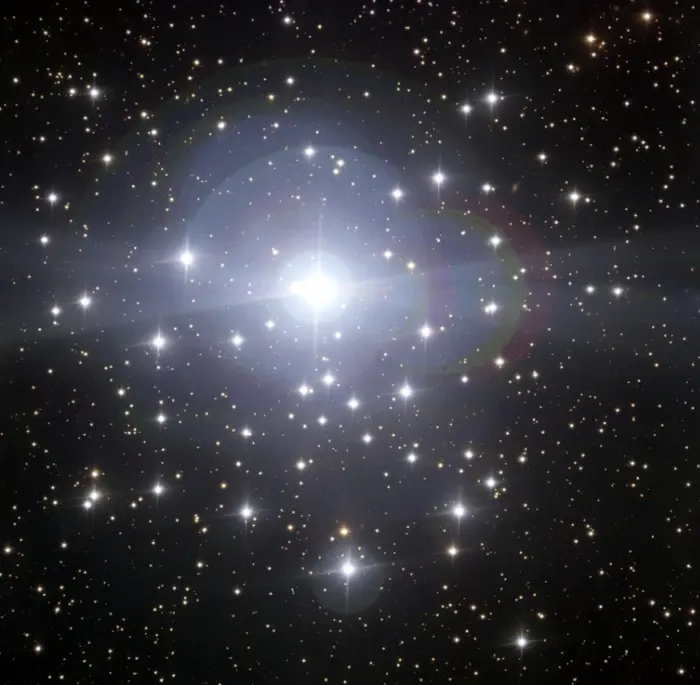
Beaming proudly from the centre of the frame is the massive multiple star system Tau Canis Majoris, the brightest member of the Tau Canis Majoris Cluster (NGC 2362) in the eponymous constellation of Canis Major (the Great Dog). Tau Canis Majoris aside, the cluster is populated by many young and less attention-seeking stars that are only four or five million years old, all just beginning their cosmic lifetimes. The Tau Canis Majoris Cluster is an open cluster — a group of stars born from the same molecular cloud. This means that all of the cluster’s members share a common chemical composition and are loosely bound together by gravity. Having been born together, they make an ideal stellar laboratory to test theories of stellar evolution. Image credit: ESO (CC BY 4.0)
Most of the cluster’s inhabitants are O- and B-type stars. These are the most short-lived types of stars that burn through their supply of nuclear fuel quickly due to their high mass.
Even though the Tau Canis Majoris Cluster is very young, it does not contain star-forming gas and dust, which indicates that star formation has stopped in the region.
Observations with the Spitzer Space Telescope in 2009 revealed that only 35 stars in the cluster showed evidence of a primordial disk. Primordial disks (or protoplanetary disks) are rotating disks of dense dust and gas that surround young pre-main sequence stars. These circumstellar disks tend to disappear on timescales of 3-10 million years.
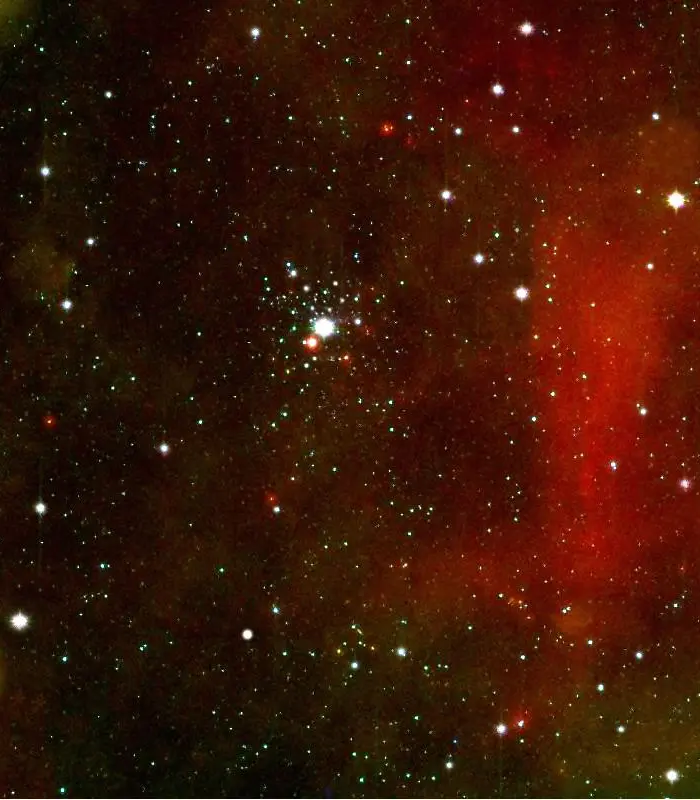
This photograph from NASA’s Spitzer Space Telescope shows the young star cluster NGC 2362. By studying it, astronomers found that gas giant planet formation happens very rapidly and efficiently, within less than 5 million years, meaning that Jupiter-like worlds experience a growth spurt in their infancy. Image credit: NASA/JPL-Caltech/Harvard-Smithsonian CfA
The cluster is named after its brightest star, the hot, luminous, blue bright giant Tau Canis Majoris (τ CMa). Tau CMa has an apparent magnitude of 4.40 and lies approximately 5,120 light-years (1,570 parsecs) away. It is visible to the unaided eye on a clear, dark night.
The star appears at the centre of the cluster. It is the only member that has stopped fusing hydrogen into helium in its core as it evolved away from the main sequence. Other members of the cluster are still on the main sequence and significantly fainter than Tau CMa.
The contrast in brightness between Tau CMa and other stars in the cluster makes the brighter star appear to jump around with respect to other members when seen in a telescope. This has earned Tau CMa the nickname the Mexican Jumping Star.
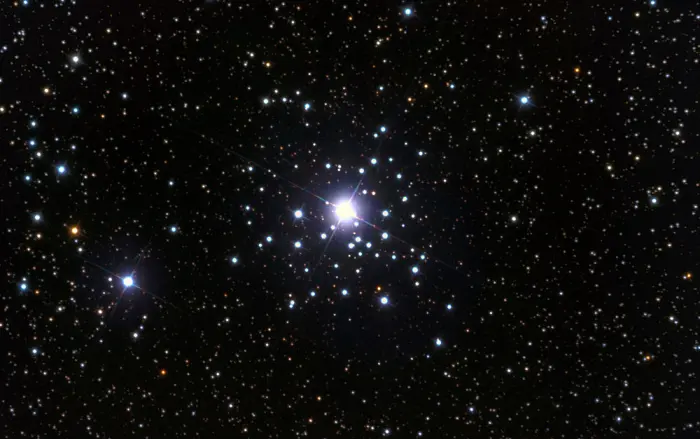
Tau Canis Majoris Cluster, image credit: Adam Block/Mount Lemmon SkyCenter/University of Arizona (CC BY-SA 3.0)
Tau Canis Majoris is in fact a multiple-star system composed of at least five components, some of them multiple stars themselves. The brightest component, Tau Canis Majoris A, is itself a spectroscopic binary star.
Tau Canis Majoris Aa, the primary component, is a blue bright giant of the spectral type O9II. It has a mass 50 times that of the Sun and a radius 19.8 times solar. With a surface temperature of 32,000 K, it is 280,000 times more luminous than the Sun.
The components Tau CMa Ab1 and Ab2 are B-type main sequence stars of the spectral class B0.5 V. Each component has an estimated mass of 17.8 solar masses. Like the primary star, they are supernova candidates.
The system is classified as a Beta Lyrae variable. Its brightness varies from magnitude 4.32 to 4.37 with a period of 1.28 days. Named after the prototype Beta Lyrae (Sheliak), Beta Lyrae variables are close binary stars that periodically pass in front of each other, blocking each other’s light. Unlike Algol-type eclipsing binary systems, Beta Lyrae stars are massive giants or supergiants that are so close to each other that mass transfer occurs between them and their shapes are ellipsoidal, distorted by mutual gravitation forces.
The O-type supergiant UW Canis Majoris (29 Canis Majoris) appears less than half a degree from Tau CMa. It was once catalogued as Tau2 Canis Majoris and is still believed to be a distant member of the cluster, but the star’s distance is still uncertain. Some estimates place it 3,800 light-years away and others at a distance of 5,000 light-years.
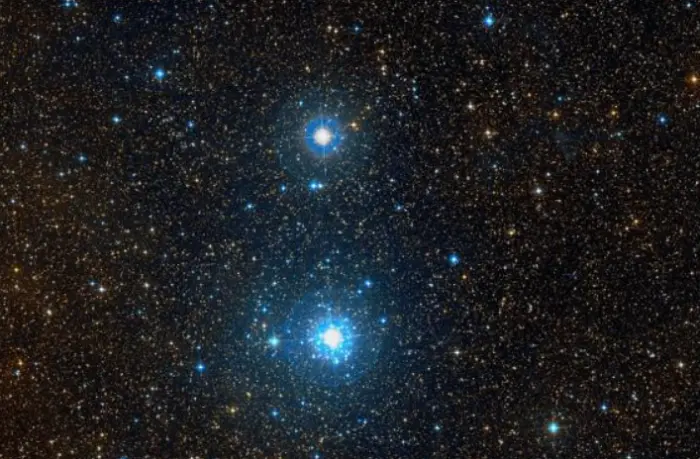
Tau Canis Majoris and UW Canis Majoris, image: Wikisky
UW Canis Majoris is the second brightest star appearing in the same line of sight as the Tau CMa Cluster. It is a close binary system catalogued as a Beta Lyrae variable. The system is composed of two luminous O-type supergiants with masses of 11-44 and 17-33 times that of the Sun. The two components orbit each other with a period of only 4.39 days. The system’s brightness varies from magnitude 4.82 to 5.33.
A giant H II region catalogued as Sharpless 310 (Sh2-310) in the Sharpless catalogue of emission nebulae appears over a degree east of the cluster. The nebula is believed to be ionized by Tau Canis Majoris, UW Canis Majoris and the early B-type stars in the Tau CMa Cluster.
Facts
The Tau Canis Majoris Cluster was discovered by the Italian astronomer Giovanni Batista Hodierna. Hodierna spotted the cluster using a Galilean-type refractor from Sicily. He included it in his 1654 catalogue De systemate orbis cometici, deque admirandis coeli characteribus (Of the systematics of the world of comets, and on the admirable objects of the sky).
Hodierna is also credited for the discovery of the Alpha Persei Cluster (Collinder 39) in the constellation Perseus, the open clusters Messier 41 in Canis Major, Messier 6 and NGC 6231 in Scorpius, Messier 36, Messier 37 and Messier 38 in Auriga, and the Lagoon Nebula (Messier 8) in Sagittarius. His catalogue is considered to be a precursor to the Messier catalogue.
More than a century after Hodierna’s discovery, the German-British astronomer Sir William Herschel included the cluster in his catalogue of stellar clusters as nebulae as entry H VII.17.
The Tau Canis Majoris Cluster is catalogued as Caldwell 64 in the Caldwell catalogue of deep sky objects visible in amateur telescopes. The cluster is also included in the Herschel 400 catalogue of objects visible from mid-northern latitudes in a 6-inch or larger telescope.
Location
The Tau Canis Majoris cluster is easy to find because it appears in the same area as Sirius (Alpha Canis Majoris), the brightest star in the night sky. The cluster lies near a triangle formed by three relatively bright stars, Adhara, Wezen, and Aludra, just south and a little east of Sirius.
NGC 2362 can be found by extending a line from Bellatrix at the shoulder of Orion through Sirius. It appears near the point where this line intersects with one drawn from Adhara through Wezen.
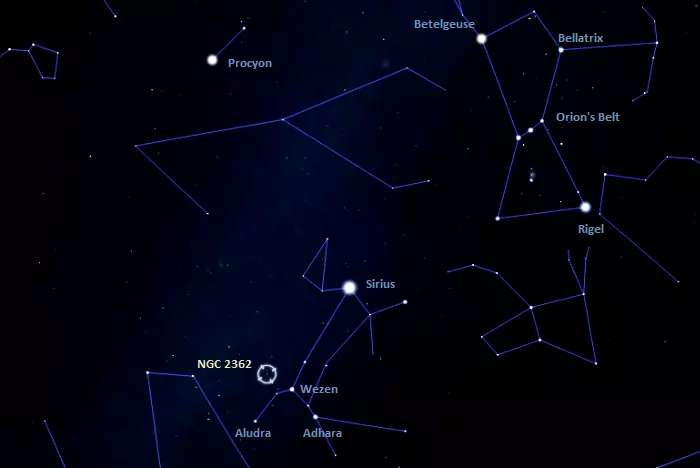
The location of the Tau Canis Majoris Cluster, image: Stellarium
The Tau Canis Majoris Cluster appears in the same area as the fainter open cluster NGC 2354, the red hypergiant VY Canis Majoris, and the star-forming region Sharpless 310 (Sh2-310).
NGC 2354 (Collinder 131) appears 2 degrees southwest of Tau Canis Majoris, just northeast of Wezen. With an apparent magnitude of 6.5, it can be seen in binoculars or a small telescope.
The pulsating red hypergiant VY Canis Majoris appears southeast of NGC 2362. With an estimated radius of 1,420 solar radii, it is one of the largest stars known. The star’s brightness varies from magnitude 6.5 to 9.6, which puts it just below unaided eye visibility at its brightest. VY CMa appears next to the vast stellar nursery Sh2-310 that stretches 681 light-years across and occupies 480 arcminutes of the apparent sky.
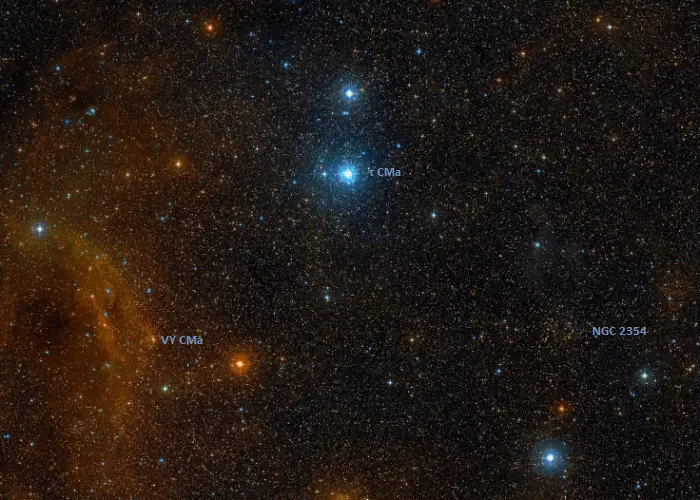
NGC 2362, NGC 2354, VY Canis Majoris and Sh2-310, image: Wikisky
The best time of the year to observe the Tau Canis Majoris Cluster and other deep sky objects in the Great Dog is during the month of February, when the constellation is high above the horizon in the evening. The cluster lies at the declination 25° S and is visible from locations south of the latitude 65° N.
Tau Canis Majoris Cluster – NGC 2362
| Constellation | Canis Major |
| Right ascension | 07h 18m 41.0s |
| Declination | −24° 57′ 18″ |
| Apparent magnitude | 3.8 |
| Apparent size | 6.2 arcminutes |
| Distance | 4.83 ± 0.97 kilolight-years (1.480 ± 0.296 kiloparsecs) |
| Mass | ≥ 500 M☉ |
| Radius | 3 parsecs (9.78 light-years) |
| Age | 5 million years |
| Names and designations | Tau Canis Majoris Cluster, NGC 2362, Caldwell 64, Collinder 136, MWSC 1173, OCl 633.0 |